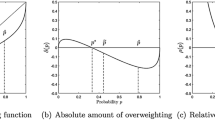Abstract
To avoid risk selection, the market for complementary health insurance is usually completely separate from the market for basic health insurance. In Switzerland, however, the basic benefit package and complementary insurance are offered by the same insurer. Risk-based premiums are allowed with respect to complementary insurance. This paper compares the Swiss integration approach to the separation approach. It is shown that under the integration approach insurers cream-skim by selling complementary insurance to low risks at a discount. Nevertheless, the integration approach can be Pareto-superior if the cost savings due to the integration of basic and complementary insurance are sufficiently large.
Similar content being viewed by others
References
Beck, K. (1998). “Kann der Risikoausgleich unterlaufen werden? Analyse der schweizerischen Ausgleichsformel,” in Gesellschaft für Recht und Politik im Gesundheitswesen (eds.), Fairneβ, Effizienz und Qualitat in der Gesundheitsversorgung: was kann der Risikostrukturausgleich dazu leisten? pp. 99–146 Springer: Heidelberg.
Bundesamt für Sozialversicherung (2000). “Veränderungen im Bereich der Zusatzversicherung aufgrund des KVG,” BSV-Forschungsbericht 04/00, Bundesamt für Sozialversicherung, Bern.
Colombo, F. (2001). “Towards More Choice in Social Protection? Individual Choice of Insurer in Basic Mandatory Health Insurance in Switzerland,” OECD Labour Market and Social Policy—Occasional Paper 53, OECD.
Danzon, P. (2002). “Welfare Effects of Supplementary Insurance: A Comment.” Journal of Health Economics 21, 923–926.
Glazer, J. and T. McGuire (2000). “Optimal Risk Adjustment in Markets with Adverse Selection: An Application to Managed Care,” American Economic Review 90, 1055–1071.
Kifmann, M. (2002). “Community Rating in Health Insurance and Different Benefit Packages,” Journal of Health Economics 21, 719–737.
Mossialos, E., S. Thomson, R. Busse, C. Economou, M. Giannoni-Mazzi, J. Hermesse, T. Hockley, M. M. Hofmarcher, H. Maarse, H. Mikkola, M. Oliveira, M. Rodrìguez, S. Sandier, C. Skoglund, P. Ulmann, and K. Vrangbæ k (2002). “Voluntary Health Insurance in the European Union,” Report prepared for the directorate general for employment and social affairs of the european commission, http://europa.eu.int/comm/employment_social/soc-prot/social/vhi.pdf.
Pauly, M. (1984). “Is Cream-Skimming a Problem for the Competitive Medical Market?,” Journal of Health Economics 3, 87–95.
Pauly, M., P. Danzon, P. Feldstein, and J. Hoff (1992). Responsible National Health Insurance. Washington, D.C. AEI Press.
Pauly, M. and B. Herring (1999). Pooling Health Insurance Risks. American Enterprise Institute: D.C. Washington.
Schellhorn, M. (2001). “The Effect of Variable Health Insurance Deductibles on the Demand for Physician Visits,” Health Economics 10, 441–456.
Werblow, A. and S. Felder (2003). “Der Einfluss von freiwilligen Selbstbehalten in der gesetzlichen Krankenversicherung: Evidenz aus der Schweiz,” Schmollers Jahrbuch 123, 235–264.
Author information
Authors and Affiliations
Corresponding author
Additional information
JEL Classification H51 · I18
Rights and permissions
About this article
Cite this article
Kifmann, M. Risk selection and complementary health insurance: The Swiss approach. Int J Health Care Finance Econ 6, 151–170 (2006). https://doi.org/10.1007/s10754-006-8162-9
Received:
Revised:
Accepted:
Issue Date:
DOI: https://doi.org/10.1007/s10754-006-8162-9




